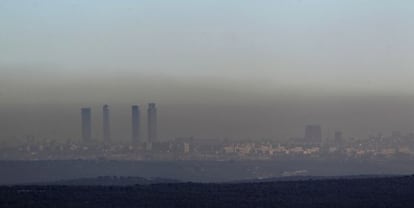Tropospheric ozone - an invisible summertime danger
Experts say government should do more to warn people about levels of pollutant


It is nearly six in the evening on July 7. A text message comes through on the cellphone: the ozone threshold at the Juan Carlos I pollution measuring station was crossed at 5pm, with a concentration of 191 micrograms/m3, and it is likely to get worse.
Anyone getting this information sitting at a sidewalk café at the opposite end of Madrid will not worry about it. But someone who has just been jogging in Juan Carlos I Park, where the measuring station is located, will wonder what the point is of learning about it so late.
Experts who know about the ill health effects of tropospheric ozone - also known as low-level ozone or bad ozone, as opposed to stratospheric ozone, which filters ultraviolet radiation - also wonder why authorities do not do a better job of informing citizens about pollution levels when they exceed safety thresholds.
The city of Madrid has an information system in place: a text messaging service that works through subscription and sends alerts to mobile devices, albeit rather late. In the southern region of Andalusia, several cities have signboards on the streets, but there are not enough of them to cover more than a few spots.
"The way the government is neglecting this issue is a cause for concern," says Federico Velázquez de Castro, a doctor in chemistry at Madrid's Complutense University and author of several studies on ozone. "Pollution information is extremely important because it saves lives."
Velázquez de Castro took part in a study that posited a relationship between heat and mortality in Seville: the analysis showed that higher ozone concentrations affected men more than women because they spent more time outdoors.
Ozone is typically a summer problem. It is a secondary pollutant, forming when other toxic gases (chiefly nitrogen oxide emissions from vehicles) react with solar radiation. Spain, just like other Mediterranean countries registering high temperatures and many hours of sunlight, is particularly exposed to ozone pollution. A report by the European Environment Agency using 2012 data shows that Spain was the EU country that most often surpassed recommended levels of this irritant gas.
Ozone shows up where nobody would expect it, far from the car exhausts that clog up city centers. It is found in city parks, on the outskirts and even in outlying municipalities. The green group Ecologists in Action has for years been asking local governments to inform citizens about pollution levels in real time. In Madrid, they suggest signboards similar to those that warn motorists about traffic jams.
"Thousands of people use public parks such as the Retiro or Casa de Campo to exercise. We have suggested areas where we think these signboards would reach the most people," says Juan García Vicente, spokesman for the organization.
People with respiratory problems are most at risk from high ozone concentration at ground level, and should be especially alert to information about environmental pollutants, notes the pulmonologist Ramón Fernández. Ozone is the summer nightmare of asthma sufferers, because it makes their condition worse. It also reduces pulmonary functions: when there is too much ozone in the air, people's breathing is quicker and shallower. Other symptoms include coughing and throat irritation.
Legislation makes it mandatory for authorities to inform citizens when a certain threshold is reached, which in the case of ozone is 180 micrograms/m3. Above that value, it is considered a health risk. At those times, local and regional authorities often recommend via their websites that at-risk groups such as children, the elderly and people with respiratory problems refrain from exercising outdoors. But does everyone have internet access?
"It is feasible to provide real-time information in areas such as parks," explains Velázquez de Castro. "Technically, it is not difficult to alert the population. There are also models providing good short-term forecasts by analyzing anticyclonic situations, temperatures and solar irradiation."
He adds that air pollution should become a regular part of media weather reports, and that authorities should conduct public health campaigns offering recommendations such as to stay well hydrated. "But I know for a fact that authorities do not want to create alarm by introducing one more cause for concern," he says.
The deputy director for air quality at the Agriculture Ministry, Maj-Britt Larka, says authorities do a good job of keeping people informed, but that the population's overall knowledge about ozone is low. "With the new air quality plan we want to improve real-time information."
Spain tops the European charts for ozone pollution. In 2012, it surpassed the health risk threshold 168 days out of the year, ahead of other hot countries such as Italy (163 days) and Greece (151 days), according to the European Environment Agency.
"Most of Europe fails to comply with ozone regulations," notes Xavier Querol, a researcher at the Higher Council for Scientific Research and a member of the committee that drafted a recent report on pollution and health for the World Health Organization.
He says that in order to bring ozone levels down, it is necessary to reduce nitrogen oxides, volatile organic compounds and other precursor gases. "Basically, you have to reduce traffic."
The EU estimates that from 2001 to 2010 between 15 and 61 percent of the continent's urban population was exposed to excessive ozone levels. Many citizens continue to breathe polluted air without even realizing it.
Tu suscripción se está usando en otro dispositivo
¿Quieres añadir otro usuario a tu suscripción?
Si continúas leyendo en este dispositivo, no se podrá leer en el otro.
FlechaTu suscripción se está usando en otro dispositivo y solo puedes acceder a EL PAÍS desde un dispositivo a la vez.
Si quieres compartir tu cuenta, cambia tu suscripción a la modalidad Premium, así podrás añadir otro usuario. Cada uno accederá con su propia cuenta de email, lo que os permitirá personalizar vuestra experiencia en EL PAÍS.
¿Tienes una suscripción de empresa? Accede aquí para contratar más cuentas.
En el caso de no saber quién está usando tu cuenta, te recomendamos cambiar tu contraseña aquí.
Si decides continuar compartiendo tu cuenta, este mensaje se mostrará en tu dispositivo y en el de la otra persona que está usando tu cuenta de forma indefinida, afectando a tu experiencia de lectura. Puedes consultar aquí los términos y condiciones de la suscripción digital.
Últimas noticias
The brief rise and retreat of Generation Z in Mexico
A floating school teaches children how to save Lake Atitlán
Pablo Escobar’s hippos: A serious environmental problem, 40 years on
From Andorra to Gibraltar, a black market for Ozempic exploits its success: ‘They’re the most sought-after products in the world’
Most viewed
- Why we lost the habit of sleeping in two segments and how that changed our sense of time
- Charles Dubouloz, mountaineering star, retires at 36 with a farewell tour inspired by Walter Bonatti
- Venezuela faces its most tense Christmas yet
- Trump’s obsession with putting his name on everything is unprecedented in the United States
- CBS in crisis after pulling a report on Trump’s deportations to El Salvador (which later leaked online)








































